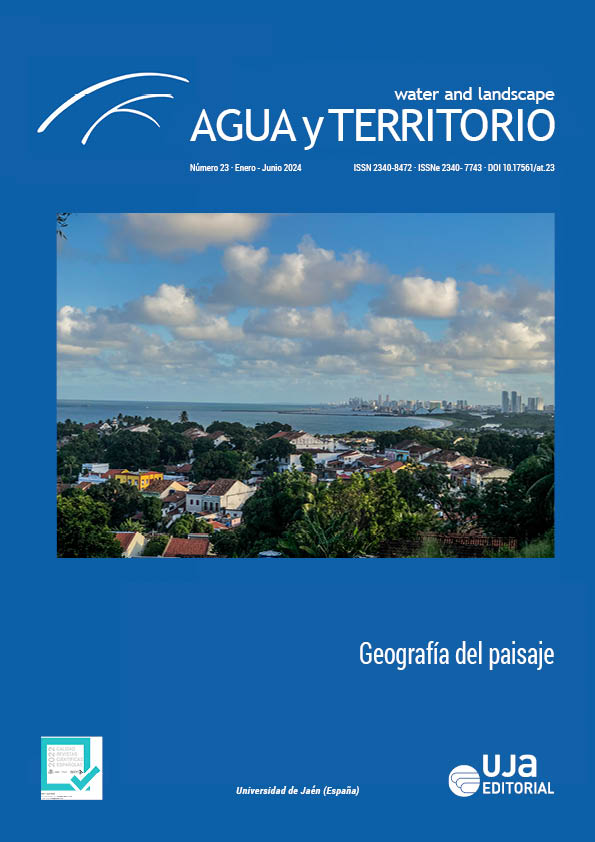El uso de imágenes de alta resolución en la elaboración de mapas de paisajes afectados por la erosión
DOI:
https://doi.org/10.17561/at.23.7291Palabras clave:
UAV, formas geomorfológicas, formas erosivas linealesResumen
Las formas erosivas lineales son la expresión de la relación entre elementos naturales y antrópicos. El objetivo del artículo fue analizar un paisaje marcado por formas erosivas a partir de imágenes de alta resolución generadas por un DJI MAVIC Pro UAV con sensor RGB CMOS. Los resultados apuntan a la posibilidad de identificar el grado de dinamicidad de los taludes erosivos de las quebradas, así como a un aumento en el detalle de los sistemas erosivos vinculados a los barrancos. La similitud entre los fenómenos identificados en campo y los presentes en la imagen también es interesante y constituye un factor que reduce drásticamente la carga con los pasos de reambulación. Se identificaron algunas limitaciones, como la necesidad de verificaciones de campo para caracterizar rupturas topográficas con afloramientos de agua y limitaciones en el proceso de fotointerpretación, provocadas, por ejemplo, por obstrucción en el campo de visión.
Descargas
Referencias
Cortês, A. R. P.; Perinotto, J. A. J. 2015: “Fácies e associação de fácies da Formação Piramboia na região de Descalvado (SP)”. Geologia USP. Série Científica, São Paulo, 15 (3-4), 23–40. https://doi.org/10.11606/issn.2316-9095.v15i3-4p23-40
Guerra, A. T; Guerra, A. J. T. 2010: Novo dicionário geológico-geomorfológico. Rio de Janeiro (Brasil), Bertrand Brasil.
Instituto Geológico Do Estado De São Paulo – IG. 1984: Formações Geológicas de Superfície. Folha Corumbataí.
Loureiro, H. A. S; Guerra, A. J. T.; Andrade, A. G. de. 2020: “Contribuição ao estudo de voçorocas a partir do uso experimental de laser scanner terrestre e VANT”. Revista Brasileira de Geomorfologia. 21 (4), 871–892. https://doi.org/10.20502/rbg.v21i4.1880
Nir, D. 1983: Man, a geomorphological agent: An introduction to Antropic Geomorphology. Jerusalem (Israel), Keter Publishing House.
Oliveira, J. B. de; Prado, H. do. 1984: Levantamento pedológico semidetalhado do estado de São Paulo. Folha São Carlos. Campinas (Brasil), IAC.
Rubey, W. W. 1928: “Gullies in the Great Plains formed by sinking of the ground”. American Journal of Science, 5–15 (89), 417–422. https://doi.org/10.2475/ajs.s5-15.89.417
Rodriguez, J. M. M; Mauro, C. A. de; Russo, I. L; Silva, C. M. dos S; Bovo, R.; Arcuri, M. E. P; Marinho, V. L. F. 1995: “Análise da paisagem como base para uma estratégia de organização geoambiental: Corumbataí (SP)”. Geografia,20 (1), 81–129.
Silva, M. M; Lupinacci, C. M. 2021: “Análise de variáveis morfométricas da Alta Bacia do Ribeirão da Boa Vista-Corumbataí (SP): subsídios ao planejamento ambiental de paisagem rural em escala de detalhe”. Geografia, 46, 1–24. https://doi.org/10.5016/geografia.v46i1.15451
Silva, M. M; Lupinacci, C. M; Stefanuto, E. B. 2022: “Análise da distribuição espacial das feições erosivas lineares na alta bacia do Ribeirão da Boa Vista -Corumbataí (SP)”. Geosul, 82, 275–302. https://doi.org/10.5007/2177-5230.2022.e77196
Tricart, J. 1965: Principles y Méthodes de la Geomorphologie. Paris (França), Maisson.
Verstappen, H. T.; Zuidan, R. A. 1975: “ITC System of geomorphological survey”. Manual ITC Textbook, 1 (8).
Wang, Y; Kuang, S; Su, J. 2016: “Critical caving erosion width for cantilever failures of river bank”. Int. J. Sediment Res., 31, 220–225. https://doi.org/10.1016/j.ijsrc.2016.05.003
Wells, R. R; Momm, H. G; Rigby, J. R; Bennett, S. J; Bingner, R. L; Dabney, S. M. 2013: “An empirical investigation of gully widening rates in upland concentrated flows”. Catena, 101, 114–121. https://doi.org/10.1016/j.catena.2012.10.004
Zanatta, F. A. S. 2018: Limitação física em área rural degradada: busca metodológica para definir o uso adequado das terras, tesis doctoral, São Paulo State University (UNESP), Rio Claro (Brasil).
Publicado
Número
Sección
Licencia
Derechos de autor 2023 Estêvão Stefanuto, Cenira Maria Lupinacci

Esta obra está bajo una licencia internacional Creative Commons Atribución 4.0.
© Universidad de Jaén
Los originales publicados en las ediciones impresa y electrónica de esta Revista son propiedad de la Universidad de Jaén siendo necesario citar la procedencia en cualquier reproducción parcial o total.
Salvo indicación contraria, todos los contenidos de la edición electrónica se distribuyen bajo una licencia de uso y distribución “Creative Commons Reconocimiento 4.0 España” (CC-by). Puede consultar desde aquí la versión informativa y el texto legal de la licencia. Esta circunstancia ha de hacerse constar expresamente de esta forma cuando sea necesario.














